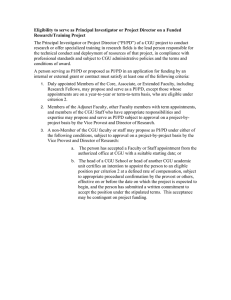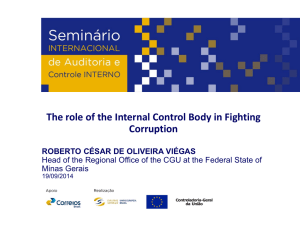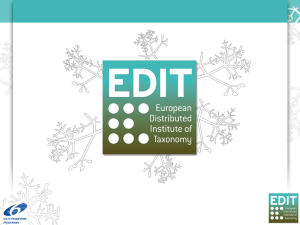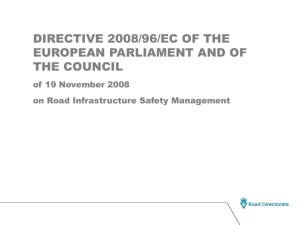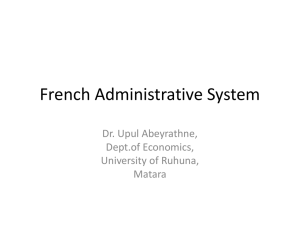Apresentação do PowerPoint
advertisement
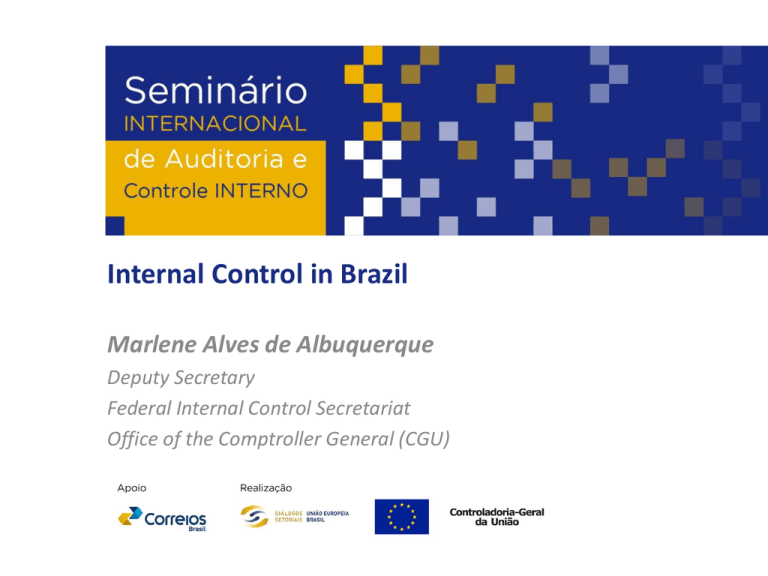
Internal Control in Brazil Marlene Alves de Albuquerque Deputy Secretary Federal Internal Control Secretariat Office of the Comptroller General (CGU) Your Presenter Marlene Alves de Albuquerque Deputy Secretary – Federal Internal Control Secretariat Finance and Control Analyst University degree in Law Graduate Studies in Public Administration General concepts (Administrative) Internal Control Also known as self control Carried out by the administration itself over all administrative acts and in accordance with legal and previously established techniques General concepts Internal Audit Set of technically standardized procedures, which works through indirect process monitoring, evaluation of results and proposition of corrective actions to management deviations of the entity to which it is linked. The internal audit work is executed by an internal audit unit, or by an internal auditor, specially assigned for the function, whose main feature is the advice to the senior management of the organization, seeking to add value to management. General concepts Internal Control System Set of technical units, coordinated by a central body, targeting the fostering of internal control responsibilities. Competences granted by the Constitution of the Federative Republic of Brazil; regulated at each level of the public administration. Control according to our Constitution Accounting, financial, budget and asset monitoring: • External Control – Congress (assisted by the Federal Court of Accounts) • Internal control system within each branch. The Legislative, Executive and Judicial Branches shall maintain an integrated system of internal control. Bodies of Internal and External Control of the Public Administration in Brazil Federal Government 26 States and the Federal District 5,570 Municipalities External Control Internal Control Federal Court of Accounts Office of the Comptroller General State Court of Office of the State Accounts Comptroller Municipal Court of Accounts Office of the Municipal Comptroller History of the Federal Internal Control CCR 1 Accounting IGF Secin Establishment 9 Centrali1 of the 2 zation 9 System 1 1 6 9 7 7 9 IC bodies were linked to the managers and focused on formal analysis (accounting) STN Focus on Finance 1 9 8 4 SFC Focus on SFC government CGU Recentralipolicies Expansion of zation 1 duties 2 9 2 0 9 0 0 4 0 0 3 The IC agency adopts a more evaluative focus (performance) Brazilian State Federal Government 26 States and the Federal District 5,570 Municipalities Common competences: • Health • Social Assistance • Education • Housing and sanitation • Environment • Historical, artistic and cultural heritage protection Brazilian State Federal Government 26 States and the Federal District 5,570 Municipalities • Executive • Legislative • Judiciary • Executive • Legislative • Judiciary • Executive • Legislative 1.2 million public servants 57% of total revenues 6 million servants 25% of total revenues 3 million servants 18% of total revenues Decentralization of the public administration Evolution of the number of municipalities 6000 5570 5000 4000 3000 2236 2000 1000 1450 700 177 473 81 218 1934-1936 1937-1945 235 0 Até Until1822 1822 1824 -1890 1891-1933 Mun. Criados Created 1946-1966 Mun. TotalTotais (Municipalities) 1967-1987 Após 1988 1988 After Internal Control System of the Federal Government The Internal Control System aims at the evaluation of government actions and the management of federal public administrators, and at supporting the external control in the exercise of its institutional mission. Federal Constitution; Law 10180 and Decree 3591 The System is comprised of: A central agency (CGU), composed by the Federal Internal Control Secretariat (SFC) and Regional CGU Offices at each Federal State Sectorial Bodies (Defense, Foreign Affairs and Presidency) Internal Audit Units (indirect administration – semi autonomous government agencies, foundations, state owned companies and joint capital enterprises – subject to regulatory orientation and technical supervision of the central agency) Internal Control Advisors within Ministries CGU is the internal control agency of the Federal Executive Branch, but is also responsible for disciplinary action, prevention and fight against corruption and the coordination of Ombudsman’s Offices. Office of the Comptroller General - CGU Executive Secretariat Federal Internal Control Secretariat (SFC) Regional Offices at each Federal State National Disciplinary Board (CRG) 2300 public servants National Ombudsman's Office (OGU) Transparency and Corruption Prevention Secretariat (STPC) Federal Internal Control Secretariat - SFC Deputy Secretary Social Directorate Infrastructure Directorate Regional CGU Offices at each Federal State Economic Directorate Production and Technology Directorate Personnel, Welfare and Labor Directorate Planning Directorate 700 servants (central unit) + 1000 allocated at the regional offices Coordinating Committee for Internal Control of the Federal Executive Branch – CCCI (Decree 3591/2000) I - conduct studies and propose measures to promote the operational integration of the Internal Control System (ICS); II - homogenize interpretations of procedures relating to the activities of the ICS; III - suggest procedures to promote the integration of ICS with other systems; IV - formulate proposals for methodologies for evaluation and improvement of the activities of the ICS V - perform analysis and case studies proposed by the CGU Minister for solving problems related to the ICS Federal Government Budget and Scope of CGU 1 Agricu lture 2 3 4 6 7 8 9 Finan ce Education Defense MRE Justice 10 11 12 MPOG US$ 904 billion budget • Refinancing - 28% 15 13 Social • Social welfare - 17%14 MT Welfare • Finance Health charges - 15% • Municipalities and State Transfers - 10% • Health - 5% • Education - 4% • Defense - 3% • Social Development - 3% Examples of approaches Education • 260 thousand civil servants • US$ 30 billions directly spent in 2013 • US$ 10.32 billions transferred to states and municipalities in 2013 Indirect Direct Adm. Adm. Foundations Formulation Execution Evaluation Semi autonomous agencies State-owned companies Joint capital enterprises Transport • 6.8 thousand civil servants • US$ 8.26 billions directly spent in 2013 CGU: full scope CGU exercises technical supervision over Internal Audits and normative orientation of its activities Lines of action of the Internal Control - CGU Evaluation of Public Programs Implementation Management Evaluation Orientation and Training Investigative Actions / Inspection Lines of action of the Internal Control - CGU Evaluation of Public Programs Implementation • Mapping out public programs • Hierarchization and Prioritization • Formulation of monitoring strategies • Inspection by lottery and sampling • 2012/2014: around 30 reports published, such as Bolsa Família (Conditioned Cash Transfer), Pensions and Educational Fund. Lines of action of the Internal Control - CGU Management Evaluation • Legal compliance and evaluation of budget, financial and property management outcomes. • Includes several activities: Annual Audits of Rendering of Accounts, Audits of Monitoring, Audits of Personnel Spending, Audits of Special Taking of Accounts, Audits of International Projects, Fiscal Management Report e Rendering of Accounts of the President of the Republic. Lines of action of the Internal Control - CGU Orientation and Training • Strengthens the preventive control by promoting training in the Audit and Inspection areas and publishing guidelines on the proper management of public resources (manuals and booklets) • Examples: voluntary transfers, rendering of accounts, procurement. Lines of action of the Internal Control - CGU Investigative Actions / Inspection • Special Audits on federal bodies and entities that CGU has identified serious problems; • Investigation of citizen complaints and inspections demanded by Public Prosecutor’s Office, Federal Police, Congressmen and other authorities; • Special Joint Operations with Federal Police. Main Partnerships 1. Federal Public Prosecutor's Office 7. Attorney General (AGU) (MPF) 8. Ministry of Justice 2. State Public Prosecutor's Offices (MPE) 9. Commission of Public Ethics 3. Federal Police (PF) 10. Central Bank 4. The Federal Court of Accounts 11. Secretariat of the Federal Revenue of Brazil 5. Council for Financial Activities Control 12. National Justice Council 6. Ministry of Planning, Budget and 13. State control bodies Management Output Delivery Management Ministries CGU Management Improvement and Internal Administrative Sanctions Senate / C. of Deputies Political Control External Control (Administrative Sanctions) TCU Tax bodies PF Disciplinary (CRG) Internal Administrative Sanctions MPF / MPE AGU Criminal Prosecution Judiciary Civil Actions Major advances over the past 12 years Inter-institutional coordination Fight against corruption Public transparency and management improvement Improvement of the legal framework Dialogue with Society International coordination Coordination with other Internal Control bodies Internal Control National Council Goals: • Coordination and joint actions of common interest • Promoting interchange of national and international experience • Organization of seminars, conferences, training • Development of programs and projects of common interest Composed by 38 state and municipal bodies of Internal Control Federal Internal Control Chief Executives Board Goal: promoting integration between internal control bodies through standardization, streamlining and updating of policies and procedures, examination of solutions to contention matters and other measures related to the performance of the functions of these bodies. Composed by the heads of internal control bodies of the Legislative, Executive and Judiciary, as well as of the Federal Public Prosecutor's Office. Coordination Goals Long term goals: • Mutual colaboration • Multiplier effect among the various levels of government • Improvement of the Brazilian public management Challenges of the Internal Control Internal Control Challenges • • • • • Recognition and management support Balance between repressive and collaborative functions Access to sensitive information (kept by third parties) Use of technology without neglecting operational issues Fostering social participation and transparency Thank you Marlene Alves de Albuquerque Deputy Secretary Federal Internal Control Secretariat Office of the Comptroller General
